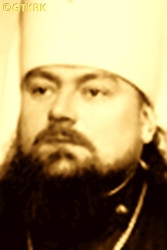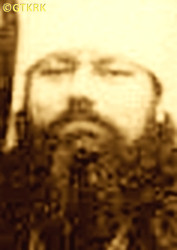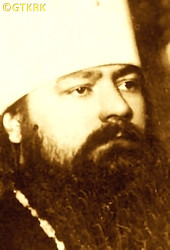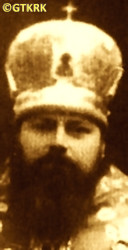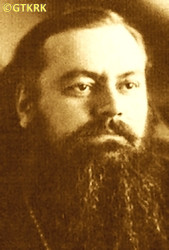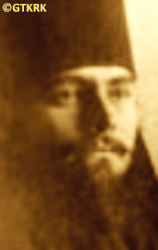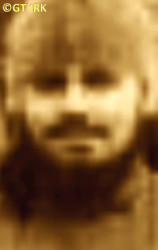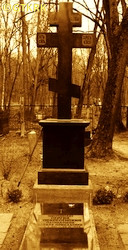Roman Catholic
St Sigismund parish
05-507 Słomczyn
85 Wiślana Str.
Konstancin deanery
Warsaw archdiocese, Poland
full list:
displayClick to display full list

searchClick to search full list by categories
wyświetlKliknij by wyświetlić pełną listę po polsku

szukajKliknij by przeszukać listę wg kategorii po polsku

Martyrology of the clergy — Poland
XX century (1914 – 1989)
personal data
surname
WOSKRIESIEŃSKI
forename(s)
Dmitry (pl. Dymitr)
religious forename(s)
Sergius (pl. Sergiusz)
function
archbishop
creed
Eastern Orthodox Church ORmore on
en.wikipedia.org
[access: 2014.09.21]
diocese / province
Vilnius and Lithuania OR eparchy
nationality
Russian
date and place
of death
29.04.1944

Kruonistoday: Kruonis eld., Kaišiadorys dist., Kaunas Cou., Lithuania
more on
en.wikipedia.org
[access: 2023.06.12]
details of death
In 1923 arrested by the Russian Bolshevik authorities for the first time and charged with „anti–Soviet agitation and propaganda”.
After 4 months of imprisonment, released „for lack of evidence”.
In 12.1930 in Orekhovo–Zuyevo arrested for the second time, on charges of „religious propaganda aimed at diverting the attention of the working masses from direct employment”.
In early 1931 released with an order to leave the city within 24 hours.
Arrested again, according to some reports, in 1935, but released thanks to his mother's petition (altogether was arrested by the communists and NKVD five times).
On 08.10.1937, after the arrest of his predecessor, became the administrator of the entire Moscow Patriarchate.
It happened at the height of the so‐called „The Great Purge”, during which the Russian communists murdered hundreds of thousands of alleged „enemies of the people” — as a result, he was then one of only four bishops of the Moscow Patriarchate in Russia to be registered as „clerics” (10 other bishops retired or were deported and in exile, the others were shot or resided outside Russia).
After the German and Russian attack on Poland in 09.1939 and the start of World War II, after the beginning of the occupation of the Baltic States by the Russians in 06.1940, became the exarch of Latvia and Estonia and the bishop of the Vilnius and Lithuanian eparchy, residing mainly in Vilnius.
After the German attack on their erstwhile ally, the Russians, on 22.06.1941, and the start of the German occupation, remained at his post in Vilnius — the area of his jurisdiction was then in the German–occupied Germ. Reichskommissariat Ostland (Eng. Reich's Commissariat East).
Immediately after the capture of Riga by the Germans in 06.1941, ordered thanksgiving services to be held in churches.
Sent priests to the German–occupied areas of Russia, where the communist persecution basically led to the destruction of the entire Orthodox clergy.
On 23.07.1942, at a meeting of his exarchate of Latvia and Estonia, convened in Riga, sent a letter of greetings to the German National Socialist leader, Adolf Hitler.
In response to this, the bishops of the Orthodox Church in Russia issued on 22.09.1942 Announcement No. 27, in which Abp Sergius was condemned as „a traitor to the Russian people”.
In reply on 22.11.1942 denounced the pro‐communist stance of his Moscow Patriarchate.
In the autumn of 1942 was to state in a sermon that „Stalin is not Saul and will never become Paul”.
On 29.04.1944, after celebrating the Holy Liturgy in the Holy Spirit church in Vilnius, went by car towards Kaunas, on his way to Riga for a funeral of a Russian artist.
On the way, c. 40 km from Kaunas, near the village of Kruonis, was murdered — along with his chauffeur and a married couple of artists–singers accompanying them.
The Germans immediately announced in the Lithuanian press under their control about Russian responsibility. They set up an investigative commission, which was to establish that around 11:00 in the morning the metropolitan's car was overtaken another car that immediately blocked its way. Three men dressed in German uniforms got out and committed the crime. The commission also announced that the attackers car had been robbed 6 days earlier in Vilnius — the robbery was allegedly carried out by 4 men, including three wearing German uniforms, who during the theft spoke „German with a foreign accent”, and later „talked to each other in Polish and Russian”. The main witness was prob. a Russian Orthodox priest who was supposed to obtain information from some Russian partisan.
On 13.07.1944 Vilnius was captured by the Russians (in practice, in the operation „Gate of Dawn”, Poles from the pro–independence underground Home Army AK, part of the Polish Clandestine State). On c. 28.08.1944 they captured Kaunas. Immediately set up their own commission, which announced that at the end of 1943, the metropolitan was to lose the support of the occupying German authorities due to his „quite independent policy”. As evidence the „Resolution of the Russian Orthodox Church on the excommunication and expulsion from the clerical state of priests who went over to the German side” of 08.09.1943 is quoted today, which he allegedly signed, although it is not clear how, since he resided in the territories occupied by the Germans. The assassination was to be carried out by „national–socialists” — Germans or Lithuanians cooperating with them.
The direct perpetrators of the murder were never discovered.
cause of death
mass murder
perpetrators
Russians (?)
sites and events
Ribbentrop‐MolotovClick to display the description, Great Purge 1937Click to display the description
date and place
of birth
07.11.1897

Moscowtoday: Moscow city, Russia
more on
en.wikipedia.org
[access: 2020.07.31]
parents
WOSKRIESIEŃSKI Nicholas
🞲 ?, ? — 🕆 ?, ?

🞲 ?, ? — 🕆 ?, ?
presbyter (holy orders)
ordination
1925

positions held
24.02.1941 – 29.04.1944
metropolita — Vilniustoday: Vilnius city dist., Vilnius Cou., Lithuania
more on
en.wikipedia.org
[access: 2022.01.06] ⋄ Vilnius and Lithuania OR eparchy — also: superior of the Holy Spirit monastery in Vilnius
24.02.1941 – 29.04.1944
exarch – patriarch's legate — Latvia and Estonia GC apostolic exarchate
08.10.1937 – 24.02.1941
administrator — Russian Orthodox Church, Moscow Patriarchate — after arrest of his predecessor by the genocidal Russian authorities (i.e. NKVD)
08.10.1937
archbishop — Russian Orthodox Church, Moscow Patriarchate — appointment date – with the right to wear a cross on a klobuk (monastic headgear)
19.07.1936 – 24.02.1941
auxiliary bishop — Dmitrovtoday: Moscow oblast, Russia
more on
en.wikipedia.org
[access: 2023.06.12] ⋄ vicariate, Russian Orthodox Church ⋄ Moscow OR eparchy
10.05.1934 – 19.07.1936
auxiliary bishop — Bronnitsytoday: Moscow oblast, Russia
more on
en.wikipedia.org
[access: 2023.06.12] ⋄ vicariate, Russian Orthodox Church ⋄ Moscow OR eparchy
from 1934
rector — Moscowtoday: Moscow city, Russia
more on
en.wikipedia.org
[access: 2020.07.31] ⋄ Transfiguration of the Lord OR church — honorary rector till 09.1942
29.10.1933 – 10.05.1934
auxiliary bishop — Kolomnatoday: Moscow oblast, Russia
more on
en.wikipedia.org
[access: 2023.06.12] ⋄ vicariate ⋄ Moscow OR eparchy
29.10.1933
Bishop — MoscowSokolnyky District
today: Moscow city, Russia
more on
en.wikipedia.org
[access: 2023.06.12] ⋄ Russian Orthodox Church, Moscow Patriarchate ⋄ Our Lord's Resurrection OR church — bishop's cheirotonia, i.e. ordination
1933
Archimandrite, i.e. superior abbot — Russian Orthodox Church, Moscow Patriarchate
1932 – 1934
presbiter (Eng. priest, i.e. iereus) — MoscowSokolnyky District
today: Moscow city, Russia
more on
en.wikipedia.org
[access: 2023.06.12] ⋄ Our Lord's Resurrection OR church
1931 – 1935
Editor in Chief — Moscowtoday: Moscow city, Russia
more on
en.wikipedia.org
[access: 2020.07.31] ⋄ „Journal of the Moscow Patriarchate” — from No. 4 (1931) to the last issue in 1935
1930 – 1931
presbiter (Eng. priest, i.e. iereus) — Orekhovo‐Zuyevotoday: Moscow oblast, Russia
more on
en.wikipedia.org
[access: 2023.06.12] ⋄ OR church
1925 – 1930
hieromonk — Moscowtoday: Moscow city, Russia
more on
en.wikipedia.org
[access: 2020.07.31] ⋄ OR monastery (i.e. Danilov monastery) — till the closure of the monastery by the Russian Bolsheviks
1925
hieromonk — Russian Orthodox Church, Moscow Patriarchate — priesthood cheirotonia, i.e. ordination, preceded by deacon cheirotonia
1925
monk — Russian Orthodox Church, Moscow Patriarchate — monastic vows
1922 – c. 1925
novitiate — Moscowtoday: Moscow city, Russia
more on
en.wikipedia.org
[access: 2020.07.31] ⋄ OR monastery (i.e. Danilov monastery)
till c. 1918
student — Moscowtoday: Moscow city, Russia
more on
en.wikipedia.org
[access: 2020.07.31] ⋄ Moscow Zaikonospaski Theological School
others related
in death
POMMERSClick to display biography John
sites and events
descriptions
Ribbentrop‐Molotov: Genocidal Russian‐German alliance pact between Russian leader Joseph Stalin and German leader Adolf Hitler signed on 23.08.1939 in Moscow by respective foreign ministers, Mr. Vyacheslav Molotov for Russia and Joachim von Ribbentrop for Germany. The pact sanctioned and was the direct cause of joint Russian and German invasion of Poland and the outbreak of the World War II in 09.1939. In a political sense, the pact was an attempt to restore the status quo ante before 1914, with one exception, namely the „commercial” exchange of the so‐called „Kingdom of Poland”, which in 1914 was part of the Russian Empire, fore Eastern Galicia (today's western Ukraine), in 1914 belonging to the Austro‐Hungarian Empire. Galicia, including Lviv, was to be taken over by the Russians, the „Kingdom of Poland” — under the name of the General Governorate — Germany. The resultant „war was one of the greatest calamities and dramas of humanity in history, for two atheistic and anti‐Christian ideologies — national and international socialism — rejected God and His fifth Decalogue commandment: Thou shall not kill!” (Abp Stanislav Gądecki, 01.09.2019). The decisions taken — backed up by the betrayal of the formal allies of Poland, France and Germany, which on 12.09.1939, at a joint conference in Abbeville, decided not to provide aid to attacked Poland and not to take military action against Germany (a clear breach of treaty obligations with Poland) — were on 28.09.1939 slightly altered and made more precise when a treaty on „German‐Russian boundaries and friendship” was agreed by the same murderous signatories. One of its findings was establishment of spheres of influence in Central and Eastern Europe and in consequence IV partition of Poland. In one of its secret annexes agreed, that: „the Signatories will not tolerate on its respective territories any Polish propaganda that affects the territory of the other Side. On their respective territories they will suppress all such propaganda and inform each other of the measures taken to accomplish it”. The agreements resulted in a series of meeting between two genocidal organization representing both sides — German Gestapo and Russian NKVD when coordination of efforts to exterminate Polish intelligentsia and Polish leading classes (in Germany called «Intelligenzaktion», in Russia took the form of Katyń massacres) where discussed. Resulted in deaths of hundreds of thousands of Polish intelligentsia, including thousands of priests presented here, and tens of millions of ordinary people,. The results of this Russian‐German pact lasted till 1989 and are still in evidence even today. (more on: en.wikipedia.orgClick to attempt to display webpage
[access: 2015.09.30])
Great Purge 1937: „Great Terror” (also «Great Purge», also called „Yezhovshchyna” after the name of the then head of the NKVD) — a Russian state action of political terror, planned and directed against millions of innocent victims — national minorities, wealthier peasants (kulaks), people considered opponents political, army officers, the greatest intensity of which took place from 09.1936 to 08.1938. It reached its peak starting in the summer of 1937, when Art. 58‐14 of the Penal Code about „counter‐revolutionary sabotage” was passed , which became the basis for the „legalization” of murders, and on 02.07.1937 when the highest authorities of Russia, under the leadership of Joseph Stalin, issued a decree on the initiation of action against the kulaks. Next a number of executive orders of the NKVD followed, including No. 00439 of 25.07.1937, starting the liquidation of 25,000‐42,000 Germans living in Russia (mainly the so‐called Volga Germans); No. 00447 of 30.07.1937, beginning the liquidation of „anti‐Russian elements”, and No. 00485[2] of 11.08.1937, ordering the murder of 139,835 people of Polish nationality (the latter was the largest operation of this type — encompassed 12.5% of all those murdered during the «Great Purge», while Poles constituted 0.4% of the population). In the summer of 1937 Polish Catholic priests held in Solovetsky Islands, Anzer Island and ITL BelbaltLag were locked in prison cells (some in Sankt Petersburg). Next in a few kangaroo, murderous Russian trials (on 09.10.1937, 25.11.1937, among others) run by so‐called «NKVD Troika» all were sentenced to death. They were subsequently executed by a single shot to the back of the head. The murders took place either in Sankt Petersburg prison or directly in places of mass murder, e.g. Sandarmokh or Levashov Wilderness, where their bodies were dumped into the ditches. Other priests were arrested in the places they still ministered in and next murdered in local NKVD headquarters (e.g. in Minsk in Belarus), after equally genocidal trials run by aforementioned «NKVD Troika» kangaroo courts.
sources
personal:
ru.wikipedia.orgClick to attempt to display webpage
[access: 2023.06.12], pl.wikipedia.orgClick to attempt to display webpage
[access: 2023.06.12], drevo-info.ruClick to attempt to display webpage
[access: 2023.06.12], obzor.ltClick to attempt to display webpage
[access: 2023.06.12], kurierwilenski.ltClick to attempt to display webpage
[access: 2023.06.12]
bibliographical:
„Hierachy, clergy and employees of the Orthodox Church in the 19th‐21st centuries within the borders of the Second Polish Republic and post–war Poland”, Fr Gregory Sosna, M. Antonine Troc-Sosna, Warsaw–Bielsk Podlaski 2017
original images:
www.pravenc.ruClick to attempt to display webpage
[access: 2023.06.12], kurierwilenski.ltClick to attempt to display webpage
[access: 2023.06.12], commons.wikimedia.orgClick to attempt to display webpage
[access: 2023.06.12], obzor.ltClick to attempt to display webpage
[access: 2023.06.12], drevo-info.ruClick to attempt to display webpage
[access: 2023.06.12], kuz1.pstbi.ccas.ruClick to attempt to display webpage
[access: 2023.06.12], kuz1.pstbi.ccas.ruClick to attempt to display webpage
[access: 2023.06.12], www.russkije.lvClick to attempt to display webpage
[access: 2023.06.12]
LETTER to CUSTODIAN/ADMINISTRATOR
If you have an Email client on your communicator/computer — such as Mozilla Thunderbird, Windows Mail or Microsoft Outlook, described at WikipediaPatrz:
en.wikipedia.org, among others — try the link below, please:
LETTER to CUSTODIAN/ADMINISTRATORClick and try to call your own Email client
If however you do not run such a client or the above link is not active please send an email to the Custodian/Administrator using your account — in your customary email/correspondence engine — at the following address:

giving the following as the subject:
MARTYROLOGY: WOSKRIESIEŃSKI Dmitry
To return to the biography press below:
 Click to return to biography
Click to return to biography








